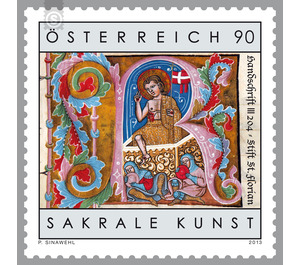Sacred art - Austria / II. Republic of Austria 2013 - 90 Euro Cent
Theme: Art & Culture
| Country | Austria / II. Republic of Austria |
| Issue Date | 2013 |
| Face Value | 90.00 |
| Edition Issued | 250,000 |
| Printing Type | combination printing |
| Stamp Type | Commemorative |
| Item Type | Stamp |
| Chronological Issue Number | 2392 |
| Chronological Chapter | OOS-OE2 |
| SID | 554956 |
| In 57 Wishlists | |
The imposing St. Florian Abbey, the largest and undoubtedly most famous Baroque monastery in Upper Austria, is located in the eponymous village near Linz. Since 1071 there is a community of Augustinian canons, the present "Congregation of Austrian Augustinian Canons". The splendid Baroque buildings with the basilica were largely preserved intact and were built between 1686 and 1750 under the master builders Carlo Antonio Carlone, Jakob Prandtauer and Johann Gotthard Hayberger. It is interesting that the origin of the monastery is not proven by sources, but an old ninth-century narration reports the martyr's death of the first known Christian of today's Austria, namely St. Florian. The so-called "Passio Floriani" tells that Florian was found after his death in 304 and found his first place of burial on the place where the convent rises today - according to this a tradition of worship of St. Florian can be found starting from the 4th Century in the place of today 's Stift suspect. The first written evidence of a monastery, however, go back to the Carolingian period around 800 AD. Of course, priceless books contain the library's own library of about 140,000 volumes, medieval manuscripts and early prints. A truly baroque jewel is the main hall, which in addition to many beautiful carpentry works also displays a famous fresco by Bartolomeo Altomonte. The Codex III 204, with which the attractive series "Sacred Art in Austria" now finds its worthy continuation, is a Missal (Missal), which was made around 1320/25 and consists of no less than 296 parchment leaves. The extremely richly decorated manuscript contains numerous initials and 39 decorative complexes, often combining several opaque initials with sumptuous framing ledges. The main parts are from a Bolognese group of painters, who worked in the late period of the St. Florian School of Painting, the text and the fleuronnierten initials created native hands. The manuscript has been carefully preserved since its creation in St. Florian. The motif of the present stamp shows Christ rising from the tomb while the two guards are sleeping. In the left hand, the risen Lord holds the Easter banner, the stigmata are still clearly visible. The initial miniature, a jewel of very special aesthetics, is connected to a broad decorative strip


